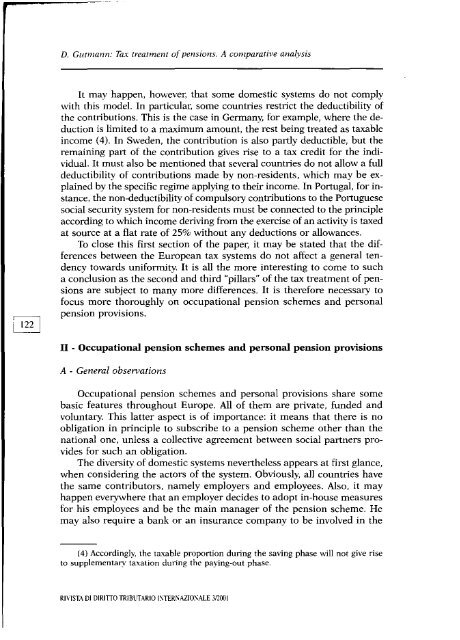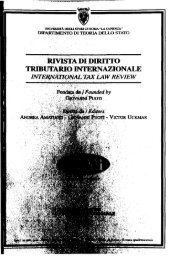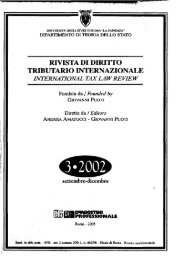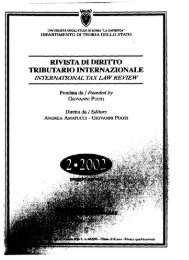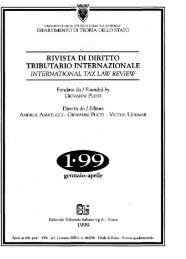RIVISTA DI DIRITTO TRIBUTARIO INTERNAZIONALE - Rdti.it
RIVISTA DI DIRITTO TRIBUTARIO INTERNAZIONALE - Rdti.it
RIVISTA DI DIRITTO TRIBUTARIO INTERNAZIONALE - Rdti.it
You also want an ePaper? Increase the reach of your titles
YUMPU automatically turns print PDFs into web optimized ePapers that Google loves.
D. GWl1lann: Tax treatme11l 01' pensions. A comparative analysis<br />
It may happen, however, that some domestic systems do not comply<br />
w<strong>it</strong>h this mode!. In particular, some countries restrict the deductibil<strong>it</strong>y of<br />
the contributions. This is the case in Germany, for example, where the deduction<br />
is lim<strong>it</strong>ed to a maximum amount, the rest being treated as taxable<br />
income (4 l. In Sweden, the contribution is also partly deductible, but the<br />
remaining part of the contribution gives rise to a tax cred<strong>it</strong> for the individuai.<br />
It must also be mentioned that several countries do not allow a full<br />
deductibil<strong>it</strong>y of contributions made by non-residents, which may be explained<br />
by the specific regime applying to their income. In Portugal, for instance,<br />
the non-deductibil<strong>it</strong>y of compulsory contributions to the Portuguese<br />
social secur<strong>it</strong>y system for non-residents must be connected to the principle<br />
according to which income deriving from the exercise of an activ<strong>it</strong>y is taxed<br />
at source at a flat rate of 25% w<strong>it</strong>hout any deductions or allowances.<br />
To dose this first section of the paper, <strong>it</strong> may be stated that the differences<br />
between the European tax systems do not affect a generaI tendency<br />
towards uniform<strong>it</strong>y. It is ali the more interesting to come to such<br />
a conclusion as the second and third "pillars" of the tax treatment of pensions<br />
are subject to many more differences. It is therefore necessary to<br />
focus more thoroughly on occupational pension schemes and personal<br />
pension provisions.<br />
II - Occupational pension schemes and personal pension provisions<br />
A - Generai observations<br />
Occupational pension schemes and personal provisions share some<br />
basic features throughout Europe. Ali of them are private, funded and<br />
voluntary. This latter aspect is of importance: il means that there is no<br />
obligation in principle to subscribe to a pension scheme other than the<br />
national one, unless a collective agreement between sodal partners provides<br />
for such an obligation.<br />
The divers<strong>it</strong>y of domestic systems nevertheless appears at first glance,<br />
when considering the actors of the system. Obviously, ali countries have<br />
the same contributors, namely employers and employees. AIso, <strong>it</strong> may<br />
happen everywhere that an employer decides to adopt in-house measures<br />
for his employees and be the main manager of the pension scheme. He<br />
may also require a bank or an insurance company to be involved in the<br />
(4) Accordingly, the taxable proportion during the saving phase wiU not give rise<br />
to supplementar:v taxation during the paying-out phase.<br />
<strong>RIVISTA</strong> <strong>DI</strong> <strong>DI</strong>RITTO <strong>TRIBUTARIO</strong> J\TERl'OAZIO\A.LE 31200!


